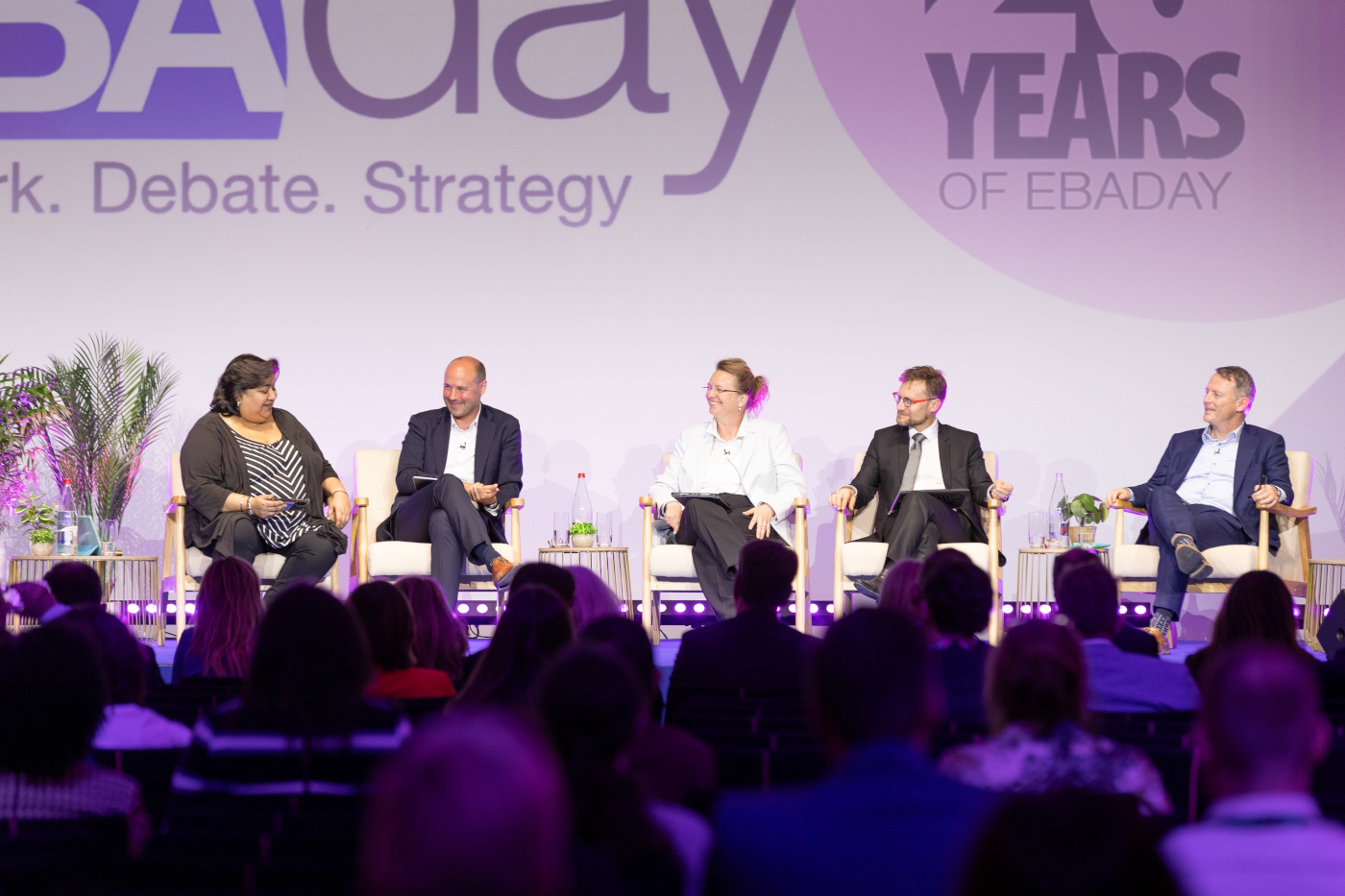16 June 2025
Europe’s regulatory agenda is undeniably full – look at market infrastructure harmonisation. The impact of red tape on competitiveness is under continuous scrutiny but how can safety and innovation work together? flow shares reflections from EBAday 2025 at the Louvre, Paris
MINUTES min read
Opening EBAday 2025 – held at Les Salles du Carrousel, underneath the Louvre – Wolfgang Ehrmann, chairman of the board, Euro Banking Association (EBA) observed that infrastructure is an often-overlooked part of the visitor experience. For payments professionals, however, this comes as no surprise. “We understand that infrastructure must be continually monitored, maintained, and improved. The behind the scenes work in payments is no longer just about keeping things running – it’s about enabling transformation,” he opened.
1. Regulation dominates in Europe
A CEO roundtable on the future of banking and payments found that Europe gravitated more towards regulation than innovation – confirmed by delegate experiences. An audience poll found “responding to compliance and regulation” (28%) beat “developing new products and value propositions” (23%) as the top priority for the next two to three years.
David Watson, President and CEO of The Clearing House noted, “In the US, what they do really well – and I believe better than in Europe – is that long before the regulation is even thought of, [the industry] is advocating … with people in government around the shape it might take.”
Establishing this US-style ‘right direction’ is something that Christian Rhino, CIO, Private Bank, Deutsche Bank, believes Europe might do well to replicate. “We are slow in Europe to define the regulation and standards and we must work together with the authorities and show them that we as the industry can bring solutions to the table,” he explained.
Taking the Instant Payments Regulation as an example, Rhino added that while the end benefits are significant – 24/7 availability, high speed, increased convenience – the operational impact of fast implementation is onerous. Institutions have limited budgets, and if the majority is allocated to mandatory investment cycles, there is a danger of eroding the private sector’s ability to innovate.

Pictured from left to right: Olivier Denecker, senior payments expert and executive adviser, Hays Littlejohn (EBA Clearing), Christian Rhino (Deutsche Bank), David Watson (The Clearing House)
“If you think of it like a centrifuge, the activity in the middle looks very slow, but around there’s a lot of energy that has to be spent,” explained Hays Littlejohn, CEO, EBA Clearing. “And sometimes the public authorities have a great level of ambition but may underestimate a little bit the practical impact and cost of implementation.”
Roundtable panellists agreed that the best response is to shift the mindset. “We need to work to manage this border together as a community, working with the authorities and governments worldwide to shape future direction,” concluded Rhino.
2. Unlock innovation
Another roundtable explored innovation. Whether through blockchain, application programming interfaces, stablecoins or cloud computing, emerging technologies are, according to Gayathri Vasudev, Global Head of Cross-border Payments at JP Morgan, the “engine of growth” for payments.
But what’s the best approach to unlocking their potential? “Wherever it comes down to customer loyalty, user experience, making sure your products operate in a resilient fashion, or differentiating offerings, they are better done internally,” explained Vasudev. “Areas like fraud prevention or security infrastructure benefit from data sharing and cross-industry collaboration.”
Institutions such as EBA and Swift standardise the ‘rails’, enabling interoperability across diverse payment systems. Getting projects over the line does require a targeted approach, however.
“We do not always need to have 10,000 banks around the table. We need a group – or a coalition of the willing – that are completely invested in the first steps and can then convince the remainder to join the respective journey,” suggested Marc Recker, Global Head of Client Solutions and Partnerships, Institutional Cash Management, Deutsche Bank.
Asked where this would leave banks that cannot afford up-front investment, Vasudev asserted that while the big banks do this, smaller players benefit from the results of this in the long term.
Recker reported that there is already promising momentum – including Project Agora, a global settlement layer between the public and private sectors designed to support CBDCs and stablecoins, as well as Partior, a blockchain-based platform that enables real-time, atomic clearing and settlement.
“We do not always need 10,000 banks around the table. We need a coalition of the willing that are completely invested in the first steps and can convince the remainder to join the respective journey”
3. G20 Roadmap: a launchpad for progress
As the G20’s Roadmap for Enhancing Cross-border Payments gains momentum, what tangible progress has been made ahead of the 2027 targets? (see G20 Roadmap: Forging a path to enhanced cross-border payments). Karyna Hutarovich, Business Product Specialist, Corporate Bank, Deutsche Bank highlighted achievements so far.
“We have to consider the scale of our ecosystem. We’re talking about more than 11,000 banks on Swift alone. We have multiple regulations and market infrastructures – it’s natural where there are challenges, but there has been a lot of progress – Swift GPI, ISO 20022, universal confirmations to name a few,” she added.
Addressing ISO 20022 progress, Hutarovich cited her work for the Committee on Payments and Market Infrastructures payment interoperability and extension taskforce, which recently released a report on harmonised minimum data requirements for ISO 20022 messages. The goal is to ensure the consistent implementation of a harmonised version of ISO 20022 across the entire payment chain, replacing the various ‘flavours’ currently in use.
“The report is basically an inventory of the ISO usage guidelines around the world and a proposal on how we can improve. It’s been great to see the level of engagement this work has sparked,” said Hutarovich. “Many market infrastructures have reached out to us – seeking guidance, asking for support, and genuinely wanting to understand the value of ISO."

Pictured from left to right: Moderator: Sulabh Agarwal (Accenture), Sara Amara (HSBC), Marianne Demarchi (Swift), Karyna Hutarovich (Deutsche Bank), Katja Lehr (JP Morgan), Ainsley Ward (CGI)
Nexus, led by the BIS Innovation Hub,1 seeks to create a standardised and scalable model that connects domestic payment systems, allowing for fast, secure, and low-cost cross-border payments. Ainsley Ward, Vice-President, Payments Consulting Services at CGI, said the initiative is really tackling the cost component. Leveraging investments in existing domestic rails, Nexus enables transactions to settle locally on both ends, reducing the cost and complexity of traditional networks, which have many costs baked in.
Yet technology alone is no panacea. “No matter what the model is, the rules, the regulation, the governance, the oversight, data privacy, data sharing and fraud need to be addressed,” warned Katja Lehr, Europe Product Head and MEA Payments and Industry & Advocacy Lead, JP Morgan Payments. “It's not going to be solved by technology or technical connectivity. We need the public [state] sector to come onboard.”
The panellists acknowledged that while meeting every goal by 2025 is unlikely, this should not hinder progress. “I believe there will be progress in certain topics such as data standardisation or interoperability, or even interlinking – but I would not treat 2027 as the finish line, but rather a launchpad for further evolution,” said Hutarovich.
4. Prepare for instant payment regulation
In October 2025, two major regulatory deadlines will take effect for Payment Service Providers (PSPs) in the eurozone: they must be capable of sending instant payments and must perform mandatory Verification of Payee (VoP) checks for all SEPA Credit Transfers and Instant Payments.2
The requirement to support sending instant payments builds on a previous mandate under the regulation, which required all PSPs to be able to receive instant payments as of January 2025. The associated ramp-up in volumes is something that the industry is bracing itself for through testing.
“What EBA Clearing has done for the community in terms of volume and performance testing is invaluable. In doing this you learn a lot about how your systems, how your applications and how your architecture actually work – such that you can make refinements ahead of the deadline,” said Dr Patrik Pohl, Managing Director Deutsche Bank, Head of Corporate Cash Management. “But testing is testing, and real life is real life. We also need to understand how we will handle exceptions – or ‘black swans’ where we see little probability, but a big impact”.
In addition, PSPs face serious implementation challenges from the new VoP requirements. Annick Moes, Head of Industry Issues, Cooperation Initiatives and Communication at the EBA warned of the potential “nightmare before Halloween”, due to the tight timelines, the required big bang approach and the remaining uncertainties, which have prevented market players from fully standardising and effectively integrating VoP in all relevant end-to-end processes and systems by October 2025.3 There is also a risk that end users will be bombarded with multiple false alarms and bulk payment processes, such as corporate payroll, might grind to a halt over minor errors.4
Pohl concluded that while the instant payment regulation started as a more consumer-driven initiative, corporates have finally woken up to what it might mean for their businesses.5
5. Fraudster DNA has shifted

Pictured from left to right: Moderator: Deepa Sinha (BAFT), Damien Dugauquier (iPiD), Monika Jacob-Schnitzius (Deutsche Bank), Olivier Jolyon (EBA Clearing), Evert Vandenbussche (KBC Global Services)
Fraud rates continue to present huge challenges to the payments sector, with US$103.6bn estimated to have been lost across the UK and Europe in 2024.6 Monika Jacob-Schnitzius, Deputy Head of Non-Financial Risk & Controls Institutional Cash Management, Deutsche Bank, stressed that the DNA of fraudsters is fundamentally shifting.
“We’re seeing financial crime being shaped and evolved by global instability, market uncertainty, digitalisation, and emerging technologies, which are each helping to facilitate the criminal system and make it more resilient to disruption.”
The birth of artificial intelligence (AI), for example, has proved a double-edged sword. “What makes AI great for our industry – accessibility, adaptability, and sophistication – also makes it a powerful tool for the criminal network,” Jacob-Schnitzius said.
Modern fraudsters have become highly inventive, and are beginning to use deepfakes, for instance, to target their victims for authorised push payments (APPs). “This is a shadow industry that has developed over many years. The fact that a term like fraud-as-a-service exists at all, speaks volumes,” she pointed out.
The unparallelled ease of access to fraud services, tools, and technologies is causing financial crime volumes to soar – and fraudsters are particularly taking advantage of the speed and irrevocability of instant payments. Olivier Jolyon, Head of New Initiatives, EBA Clearing, noted that fraud recalls in instant payments are at least nine times higher than in regular transfers: “And not only that, but it’s growing at a fast pace, increasing by more than 50% year-on-year.”
One of the trickiest financial crimes to combat is APP fraud and this means banks working together to fight it, the panel agreed. Particularly as fraudsters seem to have become even better than banks at building end-users’ trust. To invert this dynamic, banks should endeavour, said Jolyon, to “make use of the available technology to enhance their network view, continue building trust with customers and involve customers in actively fighting fraud”.
6. Pull together with ISO 20022 adoption
November 2025 marks the end of the ISO 20022-MT coexistence period that began in March 2023. But May Swift data shows that 41.2% of payment instructions traffic has already shifted from FIN to ISO 20022 messages – well below the 51% that was forecast for this period.7
These projections, as shown in the EBAday panel, “ISO 20022 migration – the final push”, indicate a steady upward trend in traffic as the deadline approaches, but Justin Brearley-Smith, Global ISO 20022 Product Lead, JP Morgan, expects it may go down to the wire. “We have another big change coming in in November – the introduction of hybrid address – and many participants won’t want to go through two rounds of testing and implementations.”
“Everyone is focused on initiation, but they need to manage it properly across all the various systems and subsystems, or else it becomes more of a box-ticking exercise”
Those opting for a big bang approach – including the “long tail” of smaller financial institutions, for whom data is less readily available – appear to be taking a more reactive stance. “Everyone is focused on initiation, but they need to manage it properly across all the various systems and subsystems, or else it becomes more of a box-ticking exercise,” said Vitus Rotzer, Chief Product Officer - Financial Messaging at Bottomline.
In some cases – particularly where participants have complex architectures with numerous applications – interim conversion may be necessary. The full benefits of ISO 20022, however, will only be realised once the entire ecosystem has transitioned to a fully ISO-native environment, described by Brearley-Smith as “the nirvana state”.
“You need the transmission and persistence of ISO data end to end to deliver on the benefits, such as supplying customers with value-added services, such as automated reconciliations on invoices,” explained Christopher Gardner, Director – Transformation & Governance, Payments ISO 20022 at Deutsche Bank.
Addressing the title of the session, panellists considered whether this is really the ‘final push’, concluding that there is much more to come. “Case management, for example, is a holistic change in how the industry is reporting on and managing enquiries, investigations and exceptions – and work needs to begin now,” warned Gardner.
The Euro Banking Association payments conference, EBAday 2025: Shaping the future of payments and transaction banking – strategies for success, took place 27–28 May 2025 at Les Salles du Carrousel, Paris. For additional insights check out Finextra TV’s video with Tsvetanka Nankova, Managing Director, Global Head of Sales Institutional Cash & Trade Finance, Deutsche Bank, who discusses the future of data, as well as the two-fold benefit of regulation like ISO 20022
All images except for lead image © Finextra
Sources
1 See bis.org
2 See europeanpaymentscouncil.eu
3 See azurewebsites.net
4 See ebaclearing.eu
5 See "How the EU Instant Payment Regulation impacts corporate treasurers" at flow.db.com
6 See compliancecorylated.com
7 See swift.com



